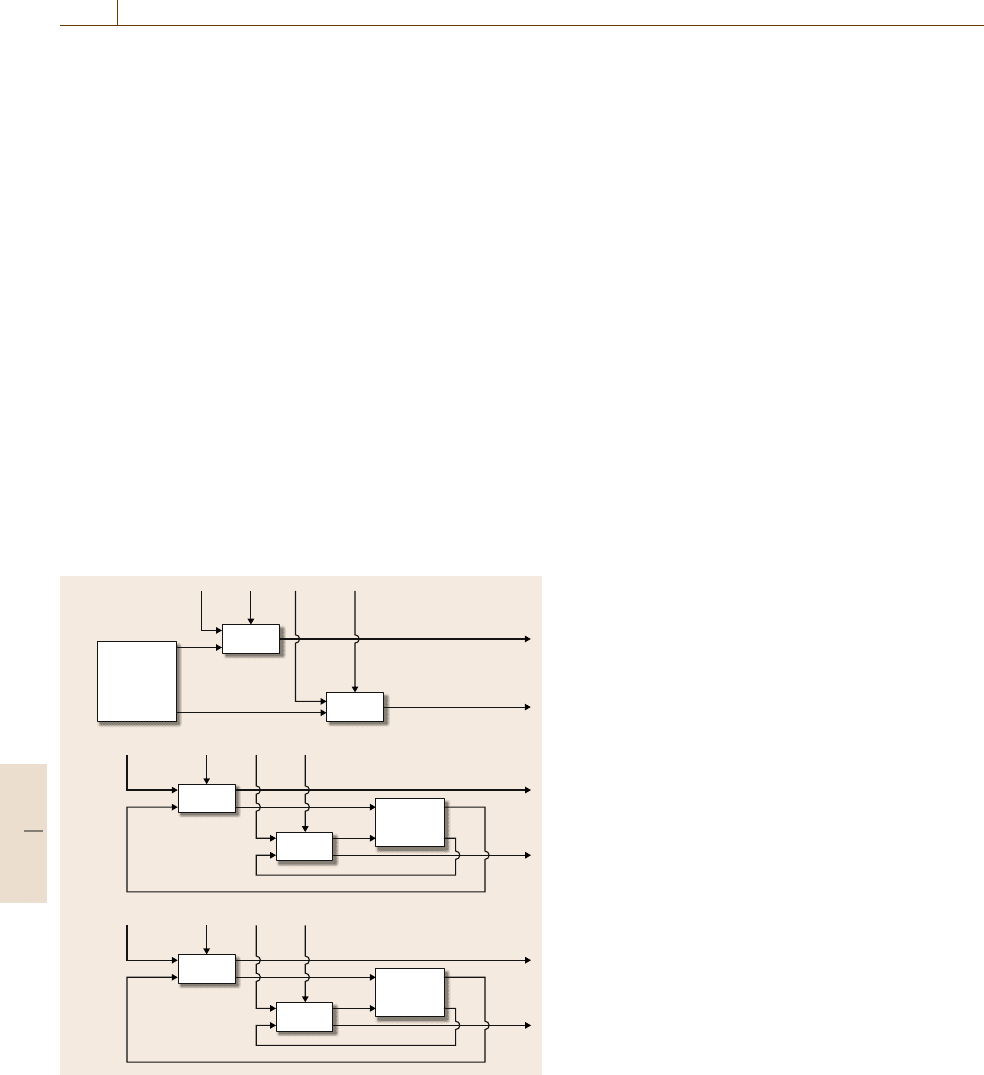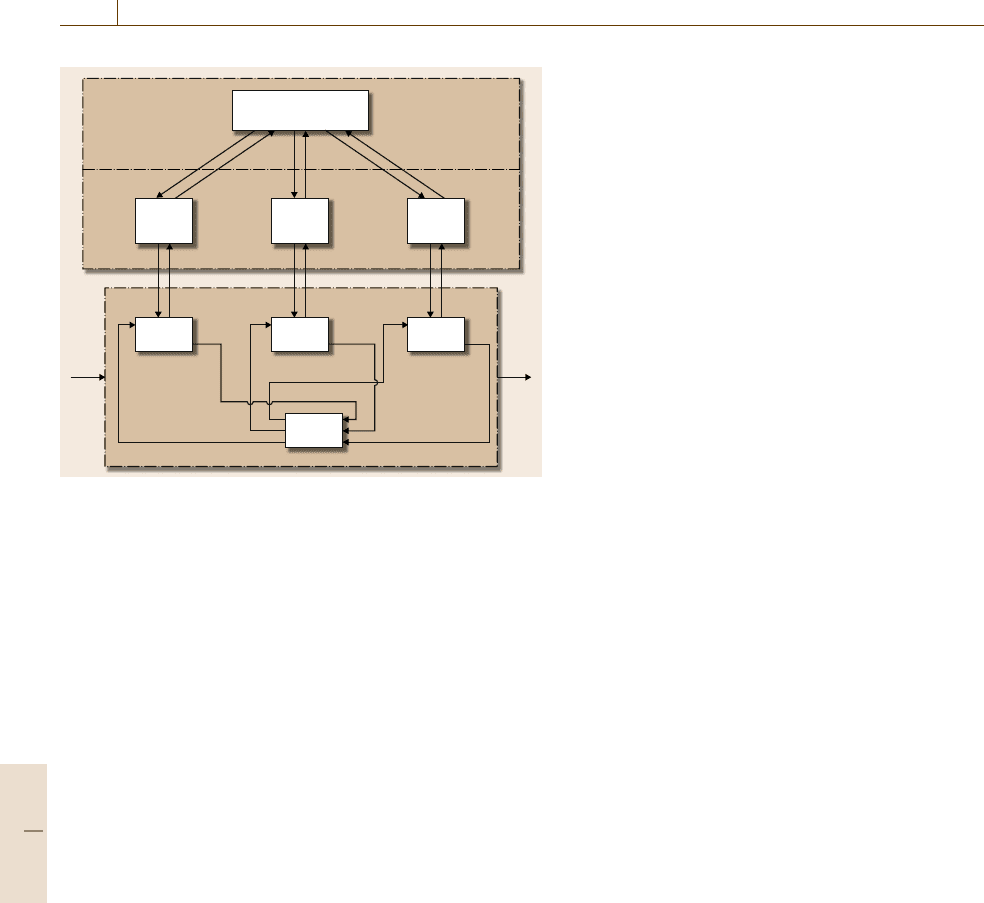Nof S.Y. Springer Handbook of Automation
Подождите немного. Документ загружается.


Machining Lines Automation 35.5 Conclusion and Perspectives 615
Table 35.5 The ranges of places Q(i) for operations
Operation i 1 2 3 4 5 6 7 8 9 10
Q(i) [1,23] [3,23] [1,15] [3,23] [3,29] [3,29] [9,29] [16,29] [16,29] [16,30]
while minimizing the number of additional machines
and/or those that move from a workstation to another
in order to rebalance the line. This problem is similar
to the design problem considered in the previous sec-
tions. Therefore, the proposed MIP model (35.1–35.17)
can be easily adapted for this new problem.
The following modifications are made in the model
(35.1–35.17): a new objective function is considered
(35.1’) along with additional constraints (35.18)and
a new set of variables (35.19) which represents the gap
between the number of machines for each station in the
line before reconfiguration (y
Old
nk
), and their number in
the line reconfigured.
Minimize
m
0
k=1
δ
+
k
+δ
−
k
,
(35.1’)
n
0
n=1
n ·y
nk
−
n
0
n=1
n ·y
Old
nk
=δ
+
k
−δ
−
k
,
∀k =1, 2,...,m
0
, (35.18)
δ
+
k
,δ
−
k
≥0 , ∀k = 1, 2,...,m
0
(35.19)
35.5 Conclusion and Perspectives
Transfer lines are used inmany manufacturing domains,
especially in machining systems, to efficiently effectu-
ate high-quality and economical production. In today’s
competitive business environment, several manufactur-
ers have opted for transfer lines to benefit from their
advantages, namely precision, quality, productivity, re-
duction of handling cost, etc. However, transfer lines
also present some drawbacks, such as requiring a large
investment. Normally, transfer lines are highly auto-
mated, but the level of automation depends on the type
of customer demand. Three types of transfer lines ex-
ist: dedicated, flexible, and reconfigurable. Dedicated
lines are composed of workstations with multispindle
heads. Flexible transfer lines have several types of CNC
machines. Reconfigurable lines offer a mix of different
types of machines (special machines, CNC machines,
machining units, etc.) and can have different architec-
tures (simple line, U-line, parallel stations, etc.).
With increasing technological progress and de-
velopment of ever more sophisticated and efficient
machining equipment, the problem of automated ma-
chining line design is exceptionally pertinent. Indeed,
the concepts for machining lines are continuously
improved through the development of new types of ar-
chitectures and machines. Unfortunately, there is a gap
between industrial cases and research problems treated.
In contrast with assembly systems, in the domain of
machining lines, the gap is often due to the lack
of collaboration between the industrial and academic
worlds.
In this chapter, written jointly by academic
(Ecole des Mines de Saint Etienne) and industrial
(PCI/SCEMM) partners, a general overview of the au-
tomated machining lines is presented. The principal
characteristics of these lines and a general methodol-
ogy for their design are introduced. This methodology
is valid independent of the type of the line: dedicated,
flexible or reconfigurable.The goal isto help machining
line manufacturers to design efficient lines and become
more competitive.
On receipt of a customer demand for a line which
includes a part description (plans, characteristics, etc.)
and the required output, the machining line manufac-
turer must be able to proposea complete solution within
a very short time interval. This preliminary solution
concerns the line architecture, number of machines,
and equipment, with a line cost evaluation. A major
difficulty deals with line balancing, which is a hard
combinatorial optimization problem. All types of trans-
fer lines are concerned. In this chapter, a short survey
of general line balancing approaches is given. The
methods developed for the balancing of the automated
machining lines are enumerated and commented. Then,
an industrial case study is presented. It illustrates and
highlights the importanceof the line balancing problem.
Afterwards, a mixed integer program for the considered
case is proposed. The presented model and approach
are useful from a practical perspective. They gener-
ate more appropriate preliminary solutions to customer
needs within a very short timeframe. From an academic
Part D 35.5

616 Part D Automation Design: Theory and Methods for Integration
point of view, this is a new formulation of the line bal-
ancing problem with sequence-dependent setup times
and parallel machines.
For future research work, beside the improvement
of the models and resolution algorithms, numerous re-
search perspectives have yet to be studied in this field.
Among them, the combination of optimization methods
and discrete-event simulation seems promising. Simu-
lation is a powerful method to illustrate and study the
flow of material on the line and to determine the effect
of its architecture on line reliability and performance.
Also, the development of interactive and iterative soft-
ware could provide useful decision-aid systems for
industry.
References
35.1 M.P. Groover: Automation, Production Systems and
Computer Integrated Manufacturing (Prentice Hall,
Eaglewood Cliffs 1987)
35.2 R.G. Askin, C.R. Standridge: Modeling and Anal-
ysis of Manufacturing Systems (Wiley, New York
1993)
35.3 K. Hitomi: Manufacturing System Engineering
(Taylor & Francis, London 1996)
35.4 A.I. Dashchenko (Ed.): Manufacturing Technologies
for Machines of the Future: 21st Century Technolo-
gies (Springer, Berlin, Heidelberg 2003)
35.5 A.I. Dashchenko (Ed.): Reconfigurable Manufactur-
ing Systems and Transformable Factories (Springer,
Berlin, Heidelberg 2006)
35.6 A. Dolgui, J.M. Proth: Les syst
`
emes de production
modernes (Hermes-Science, Paris 2006)
35.7 S.Y. Nof, W.E. Wilhelm, H.J. Warnecke: Industrial
Assembly (Chapman Hall, London 1997)
35.8 A. Kusiak: Modelling and Design of Flexible Manu-
facturing Systems (Elsevier, Amsterdam 1986)
35.9 Y. Koren, U. Heisel, F. Javane, T. Moriwaki,
G. Pritchow, H. Van Brussel, A.G. Ulsoy: Recon-
figurable manufacturing systems, CIRP Ann. 48(2),
527–598 (1999)
35.10 J. Villasenor, W.H. Mangione–Smith: Configurable
computing, Sci. Am. 276(6), 66–71 (1997)
35.11 G.W. Zhang, S.C. Zhang, Y.S. Xu: Research on
flexible transfer line schematic design using hi-
erarchical process planning, J. Mater. Process.
Technol. 129, 629–633 (2002)
35.12 A. Dolgui, O. Guschinskaya, N. Guschinsky, G. Levin:
Decision making and support tools for design of
machining systems. In: Encyclopedia of Decision
Making and Decision Support Technologies,Vol.
1, ed. by F. Adam, P. Humphreys, (Idea Group,
Hershey 2008) pp. 155–164
35.13 M.E. Salveson: The assembly line balancing prob-
lem, J. Ind. Eng. 6(4), 18–25 (1955)
35.14 A. Dolgui (Ed.): Feature cluster on the balancing
ofassemblyandtransferlines,Eur.J.Op.Res.
168(3), 663–951 (2006)
35.15 I. Baybars: A survey of exact algorithms for the sim-
ple assembly line balancing problem, Manag. Sci.
32(8), 909–932 (1986)
35.16 S. Ghosh, R.J. Gagnon: A comprehensive literature
review and analysis of the design, balancing and
scheduling of assembly line systems, Int. J. Prod.
Res. 27, 637–670 (1989)
35.17 E. Erel, S.C. Sarin: A survey of the assembly line
balancing procedures, Prod. Plan. Control 9(5),
414–434 (1998)
35.18 B. Rekiek, A. Dolgui, A. Delchambre, A. Bratcu: State
of the art of assembly lines design optimisation,
Annu.Rev.Control26(2), 163–174 (2002)
35.19 N. Boysen, M. Fliedner, A. Scholl: A classification
of assembly line balancing problems, Eur. J. Oper.
Res. 183(2), 674–693 (2007)
35.20 N. Boysen, M. Fliedner, A. Scholl: Assembly line
balancing: which model to use when?, Int. J. Prod.
Econ. 111,509–528(2008)
35.21 T.K. Bhattachajee, S. Sahu: Complexity of single
model assembly line balancing problems, Eng.
Costs Prod. Econ. 18, 203–214 (1990)
35.22 W.P. Helgeson, D.P. Birnie: Assembly line balancing
using the ranked positional weight technique, J.
Ind. Eng. 12, 394–398 (1961)
35.23 C.L. Moodie, H.H. Young: A heuristic method for
assembly line balancing for assumption of constant
or variable elements time, J. Ind. Eng. 16,23–29
(1965)
35.24 A.L. Arcus: COMSOAL: a computer method of se-
quencing operations for assembly lines, Int. J.
Prod. Res. 4(4), 259–277 (1966)
35.25 F.F. Boctor: A multiple-rule heuristic for assembly
line balancing, J. Oper. Res. Soc. 46, 62–69 (1995)
35.26 B. Rekiek, P. De Lit, A. Delchambre: Designing
mixed-product assembly lines, IEEE Trans. Robot.
Autom. 16(3), 414–434 (1998)
35.27 A. Scholl: Balancing and Sequencing of Assembly
Lines (Physica, Heidelberg 1999)
35.28 M. Amen: Heuristic methods for cost-oriented as-
sembly line balancing, A comparison on solution
quality and computing time, Int. J. Prod. Econ. 69,
255–264 (2001)
35.29 M. Amen: Heuristic methods for cost oriented as-
sembly line balancing, a survey, Int. J. Prod. Econ.
68, 1–14 (2000)
35.30 J. Bukchin, M. Tsur: Design of flexible assembly line
to minimize equipment cost, IIE Trans. 32,585–598
(2000)
35.31 J. Bukchin, A. Rubinovitz: A weighted approach
for assembly line design with station parallel-
Part D 35

Machining Lines Automation References 617
ing and equipment selection, IIE Trans. 35,73–85
(2002)
35.32 C. Andrés, C. Miralles, R. Pastor: Balancing and
scheduling tasks in assembly lines with sequence-
dependent setup times, Eur. J. Oper. Res. 187(3),
1212–1223 (2008)
35.33 J. Szadkowski: Critical path concept for multi-tool
cutting processes optimization. In: Manufacturing
Systems Modeling, Management and Control: Pro-
ceedings of the IFAC Workshop, ed. by P. Kopacek
(Elsevier, Vienna 1997) pp. 393–398
35.34 A. Dolgui, N. Guschinski, G. Levin: On problem
of optimal design of transfer lines with paral-
lel and sequential operations, Proc. 7th IEEE Int.
Conf. Emerg. Technol. Fact. Autom. (ETFA’99), Vol. 1,
ed. by J.M. Fuertes (IEEE, Barcelona 1999) pp. 329–
334
35.35 S. Belmokhtar: Lignes d’usinage avec équipements
standards: modélisation, configuration et opti-
misation. Ph.D. Thesis (Ecole des Mines de Saint
Etienne, Saint Etienne 2006), in French
35.36 S.Belmokhtar,A.Dolgui,N.Guschinsky,G.Levin:
An integer programming model for logical layout
design of modular machining lines, Comput. Ind.
Eng. 51(3), 502–518 (2006)
35.37 A.Dolgui,B.Finel,N.Guschinsky,G.Levin,F.Ver-
nadat: MIP approach to balancing transfer lines
with blocks of parallel operations, IIE Trans. 38,
869–882 (2006)
35.38 A. Dolgui, N. Guschinsky, G. Levin: A Special case of
transfer lines balancing by graph approach, Eur. J.
Oper. Res. 168(3), 732–746 (2006)
35.39 A. Dolgui, N. Guschinsky, G. Levin, J.M. Proth: Opti-
misation of multi-position machines and transfer
lines, Eur. J. Oper. Res. 185(3), 1375–1389 (2008)
35.40 A. Dolgui, I. Ihnatsenka: Branch and bound
algorithm for a transfer line design problem: sta-
tions with sequentially activated multi-spindle
heads, Eur. J. Op. Res. (2007) available online,
doi:10.1016/j.ejor.2008.03.028, (in press)
35.41 A. Dolgui, I. Ihnatsenka: Balancing modular trans-
fer lines with serial-parallel activation of spindle
heads at stations, Discret. Appl. Math. 157(1), 68–
89 (2009)
35.42 W.E. Wilhelm: A column-generation approach for
the assembly system design problem with tool
changes, Int. J. Flex. Manuf. Syst. 11, 177–205 (1999)
35.43 O. Guschinskaya, A. Dolgui, N. Guschinsky, G. Levin:
A heuristic multi-start decomposition approach for
optimal design of serial machining lines, Eur. J.
Oper. Res. 189(3), 902–913 (2008)
35.44 B. Finel: Structuration de lignes d’usinage: méth-
odes exactes et heuristiques. Ph.D. Thesis (Univer-
sité de Metz, Metz 2004), in French
35.45 A.Dolgui,B.Finel,N.Guschinsky,G.Levin,F.Ver-
nadat: An heuristic approach for transfer lines
balancing, J. Intell. Manuf. 16(2), 159–171 (2005)
35.46 B. Finel, A. Dolgui, F. Vernadat: A random search
and backtracking procedure for transfer line bal-
ancing, Int. J. Comput. Integr. Manuf. 21(4),
376–387 (2008)
35.47 M. Essafi, X. Delorme, A. Dolgui: A heuristic method
for balancing machining lines with paralleling of
stations and sequence-dependent setup times,
Proc. Int. Workshop LT’2007 (Sousse 2007) pp. 349–
354
35.48 O. Guschinskaya: Outils d’aide à la décision
pour la conception en avant-projet des systèmes
d’usinage à boîtiers multibroches. Ph.D. Thesis
(Ecole des Mines de Saint Etienne, Saint Etienne
2007), in French
35.49 S. Masood: Line balancing and simulation of an
automated production transfer line, Assem. Au-
tom. 26(1), 69–74 (2006)
Part D 35
“This page left intentionally blank.”

619
Large-Scale C
36. Large-Scale Complex Systems
Florin-Gheorghe Filip, Kauko Leiviskä
Large-scale complex systems (LSS) have tradi-
tionally been characterized by large numbers of
variables, structure of interconnected subsys-
tems, and other features that complicate the
control models such as nonlinearities, time de-
lays, and uncertainties. The decomposition of LSS
into smaller, more manageable subsystems al-
lowed for implementing effective decentralization
and coordination mechanisms. The last decade re-
vealed new characteristic features of LSS such as
the networked structure, enhanced geographical
distribution and increased cooperation of subsys-
tems, evolutionary development, and higher risk
sensitivity. This chapter aims to present a balanced
review of several traditional well-established
methods and new approaches together with typ-
ical applications. First the hierarchical systems
approach is described and the transition from
coordinated control to collaborative schemes is
highlighted. Three subclasses of methods that
arewidelyutilizedinLSS – decentralized control,
simulation-based, and artificial-intelligence-
based schemes – are then reviewed. Several basic
aspects of decision support systems (DSS) that are
36.1 Background and Scope.......................... 620
36.1.1 Approaches ................................. 621
36.1.2 History........................................ 622
36.2 Methods and Applications ..................... 622
36.2.1 Hierarchical Systems Approach....... 622
36.2.2 Other Methods and Applications .... 626
36.3 Case Studies ......................................... 632
36.3.1 Case Study 1:
Pulp Mill Production Scheduling..... 632
36.3.2 Case Study 2: Decision Support
in Complex Disassembly Lines........ 633
36.3.3 Case Study 3: Time Delay Estimation
in Large-Scale Complex Systems..... 634
36.4 Emerging Trends .................................. 634
References .................................................. 635
meant to enable effective cooperation between
man and machine and among the humans
in charge with LSS management and control
are briefly exposed. The chapter concludes by
presenting several technology trends in LSS.
There is not yet a universally accepted definition of
the large-scale complex systems (LSS) though the LSS
movement started more than 40 years ago. However, by
convention, one may say that a particular system is
a large and complex one if it possesses one or several
characteristic features. For example, according to To-
movic [36.1], the set of LSS characteristics includes the
structure of interconnected subsystems and the presence
of multiple objectives, which, sometimes, are vague and
even conflicting. A similar viewpoint is proposed by
Mahmoud, who describes a LSS as [36.2]:
A system which is composed of a number of smaller
constituents, which serveparticular functions, share
common resources, are governed by interrelated
goals and constraints and, consequently, require
more than one controllers.
ˇ
Siljak [36.3] states that a LSS is characterized by
its high dimensions (large number of variables), con-
straints in the information infrastructure, and the
presence of uncertainties. At present there are soft-
ware products on the market which can be utilized
Part D 36

620 Part D Automation Design: Theory and Methods for Integration
to solve optimization problems with thousands of
variables. A good example is Solver.com [36.4].
Complications may still be caused by system non-
linearities, time delays, and different time constants,
and, especially over recent years, risk sensitivity
aspects.
36.1 Background and Scope
In real life one can encounter lots of natural, man-
made, and social entities that can be viewed as LSS.
From the early years of the LSS movement,theLSS
class has included several particular subclasses such
as: steelworks, petrochemical plants, power systems,
transportation networks, water systems, and societal
organizations [36.5–7]. Interest in designing effective
control schemes for such systems was primarily moti-
vated by the fact that even small improvements in the
LSS operations could lead to large savings and impor-
tant economic effects.
The structure of interconnected subsystems has ap-
parently been the characteristic feature of LSS to be
found in the vast majority of definitions. Several sub-
classes of interconnections can be noticed (Fig.36.1).
Resources
w
1
u
1
SSy
1
SSy
2
u
2
w
2
m
2
m
1
y
2
y
1
a)
w
1
u
1
u
2
SSy
1
SSy
2
u = h(z)
w
2
m
2
z
1
z
2
m
1
y
2
y
1
b)
w
1
u
1
u
2
SSy
1
SSy
2
s = g(s,z)
u = h(s)
w
2
m
2
z
1
z
2
m
1
y
2
y
1
c)
Fig. 36.1a–c Interconnection patterns: (a) resource sharing, (b) di-
rect interconnection,
(c) flexible interconnection; SSy = subsystem,
m = control variable, y = output variable, w = disturbance, u =
interconnection input, z = interconnection output, g(·) = stock dy-
namics function, h(·) =interconnection function
First there are the resource sharing interconnections
described by Findeisen [36.8], which can be identi-
fied at the system level as remarked by Takatsu [36.9].
Also, at the system level, subsystems may be inter-
connected through their common objectives [36.8].
Subsystems may also be interconnected through buffer
units (tanks), which are meant to attenuate the ef-
fects of possible differences in the operation regimes
of plants which feed or drain the stock in the buffer.
This type of flexible interconnection can frequently
be met in large industrial and related systems such
as refineries, steelworks, and water systems [36.10].
The dynamics of the stock value s in the buffer unit
can be modeled by a differential equation. In some
cases buffering units are not allowed because of tech-
nological reasons; for example, electric power cannot
be stocked at all and reheated ingots in steelworks
must go immediately to rolling mills to be processed.
When there are no buffer units, the subsystems are
coupled through direct interconnections,attheprocess
level [36.9].
In the 1990s, integration of systems continued and
new paradigms such as the extended/networked/virtual
enterprise were articulated to reflect real-life develop-
ments. In this context, Mårtenson [36.11] remarked
that complex systems became even more complex.
She provided several arguments to support her remark:
first, the ever larger number of interacting subsystems
that perform various functions and utilize technolo-
gies belonging to different domains such as mechanics,
electronics, and information and communication tech-
nologies (ICT); second, that experts from different
domains can encounter hard-to-solve communication
problems; and also, that people in charge of control and
maintenance tasks, who have to treat both routine and
emergence situations, possess uneven levels of skills
and training and might even belong todifferent cultures.
Nowadays, Nof et al. show that [36.12]:
There is the need to create the next generation man-
ufacturing systems with higher levels of flexibility,
allowing these systems to respond as a component
of enterprise networks in a timely manner to highly
dynamic supply-and-demand networked markets.
Part D 36.1

Large-Scale Complex Systems 36.1 Background and Scope 621
Table 36.1 Summary of methods described in this chapter
Decomposition-coordination-based Mesarovic, Macko, Takahara [36.7]; Findeisen et al. [36.16];
methods Titli [36.17]; Jamshidi [36.6]; Brdys, Tatjewski [36.18]
Optimization-based methods Dourado [36.19]; Filip, et al. [36.20]; Filip et al. [36.21];
Guran et al. [36.22]; Peterson [36.23]; Tamura [36.24]
Decentralized control Aybar et al. [36.25]; Bakule [36.26]; Borrelli et al. [36.27];
Inalhan et al. [36.28]; Krishnamurthy et al. [36.29];
Langbort et al. [36.30];
ˇ
Siljak et al. [36.31];
ˇ
Siljak et al. [36.32]
Simulation-based methods Arisha and Yong [36.33]; Chong et al. [36.34]; Filip et al. [36.20];
Gupta et al. [36.35]; Julia and Valette [36.36]; Lee et al. [36.37];
Leivisk
¨
a et al. [36.38,39]; Liu et al. [36.40];
Ramakrishnan et al. [36.41]; Ramakrishnan and Thakur [36.42];
Taylor [36.43]
Intelligent methods
• Fuzzy logic Ichtev [36.44]; Leivisk
¨
a [36.45]; Leivisk
¨
a and Yliniemi [36.46];
• Neural networks Arisha and Yong [36.33]; Azhar et al. [36.47]; Hussain [36.48];
Liu et al. [36.49]
• Genetic algorithms Dehghani et al. [36.50]; El Mdbouly et al. [36.51]; Liu et al. [36.40]
• Agent-based methods Akkiraju et al. [36.52]; Hadeli et al. [36.53]; Heo and Lee [36.54];
Ma
ˇ
r
´
ık and La
ˇ
zansk
´
y [36.55]; Park and Lim [36.56]; Parunak [36.57]
They also emphasize that e-Manufacturing is highly
dependent on the efficiency of collaborative human–
human and human–machine e-Work. See Chap.88 on
Collaborative e-Work, e-Business, and e-Service.In
general, there is a growing trend to understand the
design, management, and control aspects of complex
supersystems or systems of systems (SoS). Systems
of systems can be met in space exploration, mili-
tary and civil applications such as computer networks,
integrated education systems, and air transportation sys-
tems. There are several definitions of SoS,mostof
them being articulated in the context of particular ap-
plications; for example, Sage and Cuppan [36.13] state
that a SoS is not a monolithic entity and possesses
the majority of thefollowingcharacteristics: geographic
distribution,operational andmanagement independence
of its subsystems, emergent behavior, and evolutionary
development. All these developments obviously im-
ply ever more complex control and decision problems.
A particular case which has received a lot of attention
over recent years is large-scale critical infrastructures
(communication networks, the Internet, highways, wa-
ter systems, and power systems) that serve not only the
business sector but society in general [36.14, 15]. All
of these recent developments are likely to provide fresh
strong stimuli for new research in the LSS domain.
36.1.1 Approaches
The progresses made in information and commu-
nication technologies have enabled the designer to
overcome severaldifficultieshe mighthave encountered
when approaching a LSS, in particular those caused
by a large number of variables and the low perfor-
mance (with respect to throughput and reliability) of
communication links. However, as Cassandras points
out [36.58]:
The complexity of systems designed nowadays is
mainly defined by the fact that computational power
alone does not suffice to overcome all difficulties
encountered in analyzing, planning and decision-
making in the presence of uncertainties.
A plethora of methods have been proposed over
the last four decades for managing and controlling
large-scale complex systems such as: decomposition,
hierarchical control and optimization, decentralized
control, model reduction, robust control, perturbation-
Part D 36.1

622 Part D Automation Design: Theory and Methods for Integration
based techniques, usage of artificial-intelligence-based
techniques, integrated problems of system optimiza-
tion and parameter estimation [36.59], and so on. Two
common ideas can be found in the vast majority of
approaches proposed so far:
a) Replacing the original problem with a set of sim-
pler ones which can be solved with the available
tools and accepting the satisfactory, near optimal
solutions
b) Exploiting the particular structure of each system to
the extent possible.
Table 36.1 presents a summary of the main methods
to be described in this chapter.
36.1.2 History
Though several ideas and methods for controlling LSSs
were proposed in the 1960s and even earlier, it is ac-
cepted by many authors that the book of Mesarovic
et al. published in 1970 [36.7] triggered the LSS move-
ment. The concepts revealed in that book, even though
they were strongly criticized in 1972 by Va ra iya [36.60]
(an authority among the pioneers of the LSS move-
ment), have inspired many academics and practitioners.
A series of books including those of Wismer [36.61],
Titli [36.17], Ho and Mitter [36.62], Sage [36.63],
ˇ
Siljak [36.3,64], Singh [36.65], Findeisen et al. [36.16],
Jamshidi [36.6], Lunze [36.66], and Brdys and Tat-
jewski [36.18] followed on and contributed to the
consolidation of the LSS domain of research and paved
the way for practical applications.
In 1976, the first International Federation of Au-
tomatic Control (IFAC) conference on Large-Scale
Systems: Theory and Applications washeldinUdine,
Italy. This was followed by a series of symposia which
were organized by the specialized Technical Commit-
tee of IFAC and took place in various cities in Europe
and Asia (Toulouse, Warsaw, Zurich, Berlin, Beijing,
London, Patras, Bucharest, Osaka, and Gdansk). The
scientific journal Large Scale Systems published by
North Holland played an important role in the devel-
opment of LSS domain, especially in the 1980s.
36.2 Methods and Applications
36.2.1 Hierarchical Systems Approach
The central idea of the hierarchical multilevel systems
(HMS) approach to LSS consists of replacing the orig-
inal system (and the associated control problem) with
a multilevel structure of smaller subsystems (and asso-
ciated less complicated problems). The subproblems at
the bottom of the hierarchy are defined by the interven-
tions made by the higher-level subproblems, which in
turn utilize the feedback information they receive from
the solutions of the lower-level subproblems.
There are three main subclasses of hierarchies
which can be obtained in accordance with the complex-
ity of description, control task,andorganization [36.7].
Levels of Description
The first step in analyzing an LSS and designing the
corresponding control scheme consists of model build-
ing. As Steward [36.67] points out, practical experience
witnessed there is a paradoxical law of systems.Ifthe
description of the plant is too complicated, then the de-
signer istempted to consider only a part ofthe systemor
a limited sets of aspects which characterize its behavior.
In this case it is very likely that the very ignored parts
and aspects have a crucial importance. Consequently it
emerges that more aspects should be considered, but
this may lead to a problem which is too complex to be
solved in due time. To solve the conflict between the
necessary simplicity (to allow for the usage of exist-
ing methods and tools with a reasonable consumption
of time and other computer resources) and the accept-
able precision (to avoid obtaining wrong or unreliable
results), the LSS can be represented by a family of mod-
els. These models reflect the behavior of the LSS as
viewedfrom various perspectives, called [36.7] levels of
description or strata,orlevels of influence [36.63,68].
The description levels are governed by independent
laws and principles and use different sets of descrip-
tive variables. The lower the level is, the more detailed
the description of a certain entity is. A unit placed on
the n-th level may be viewed as a subsystem at level
n−1. For example, the same manufacturing system can
be described from the top stratum in terms of economic
and financial models, and, at the same time, by control
variables (states, controls, and disturbances) as viewed
from the middle stratum, or by physical and chem-
ical variables as viewed from the bottom description
level (Fig.36.2).
Part D 36.2

Large-Scale Complex Systems 36.2 Methods and Applications 623
Levels of Control
In order to act in due time even in emergency situ-
ations, when the available data are uncertain and the
decision consequences are not fully explored and eval-
uated, a hierarchy of specialized control functions can
be an effective solution as shown by Eckman and
Lefkowitz [36.70]. Several examples of sets of levels of
control are:
a) Regulation, optimization, and organization [36.71]
b) Direct control, supervisory control, optimization,
and coordination [36.72]
c) Stabilization, dynamic coordination, static opti-
mization, and dynamic optimization [36.8]
d) Measurement and regulation, production planning
and scheduling, and business planning [36.73].
The levels of control, also called layers by
Mesarovic et al. [36.7], can be the result of a time-scale
decomposition. They can be defined on the basis of
time horizons taken into consideration, or the frequency
of disturbances which may show up in process vari-
ables, operation conditions, parameters, and structure
of the plant as stated by Schoeffler [36.68], as shown
in Fig.36.2.
Organization layers
(echelons)
General
management
Production
control
Unit process
control
Economic representations
Regulation
Disturbance frequency in
… process variables
… input variables
… plant structure
Optimization
Organization
Control models
Physical variables
Description levels
(strata)
Control levels
(layers)
Fig. 36.2 A hierarchical system approach applied to an industrial plant (after [36.69])
Levels of Organization
The hierarchies based on the complexity of orga-
nization were proposed in mid 1960s by Brosilow
et al. [36.74]andLasdon and Schoeffler [36.75]and
were formalized in detail by Mesarovic et al. [36.7].
The hierarchy with several levels of organization,
also called echelons by Mesarovic et al. [36.7], has
been, for many years, a natural solution for man-
agement of large-scale military, industrial, and social
systems, which are made up of several intercon-
nected subsystems when a centralized scheme can-
not be either technically possible or economically
acceptable.
The central idea of the multiechelon hierarchy is
to place the control/decision units, which might have
different objectives and information bases, on several
levels of a management and control pyramid. While
the multilayer systems implement the vertical divi-
sion of the control effort, the multiechelon systems
include also a horizontal division of work. Thus, on
the n-th organization level the i-th control unit, CU
n
i
,
has limited autonomy. It sends coordination signals
downwards to a well-defined subset of control units
which are placed at the level n−1 and it receives co-
ordination signals from the corresponding unit placed
Part D 36.2

624 Part D Automation Design: Theory and Methods for Integration
Coordinator
Level 2
Level 1
w
y
CU
2
CU
3
CU
1
SSy
2
H
SSy
3
SSy
1
m
1
m
2
u
1
z
1
z
2
z
3
y
1
y
2
α
2
α
3
α
1
β
2
β
3
β
1
y
3
m
3
u
3
u
2
Fig. 36.3 A simple two-level multilevel control system (CU =
control unit, SSy = controlled subsystem, H = interconnection
function, m = control variable, u = input interconnection variable,
z = output interconnection variable, y = output variable, w = dis-
turbance)
on level n +1. The unit on the top of the pyra-
midiscalledthesupremal coordinator and the units
to be found at the bottom level are called infimal
units.
Manipulation
of Complex Mathematical Problems
To take advantage of possible benefits of hierarchical
multilevel systems a systematic decomposition of the
original large-scale system and associated control prob-
lem is necessary. There are many situations when the
control problem maybe formulatedas (orreduced to)an
optimization problem (P1), which is, defined in general
terms as
(P1) : extr
v
J(v); v ∈ V , (36.1)
where v is the decision variable (a scalar, or a vector),
V is the admissible variation domain (which can be
defined by differential or difference equations and/or al-
gebraic inequations), and J is the performance measure
(which can be a function or a functional).
The decomposition methods are based on var-
ious combinations of several elementary manipula-
tions [36.76]. There are two main subsets of elementary
manipulations:
a) Transformations, which are meant to substitute the
original large-scale complex problem by a more ma-
nipulable one
b) Decompositions, which are meant to replace alarge-
scale problem by a number of smaller subproblems.
In the sequel several elementary manipulations
will be reviewed following the lines exposed by
Wilson [36.76].
The variable transformation replaces the original
problem (P1) by an equivalent one (P2) through the
utilization of a new variable y = f(x) and a new per-
formance measure Q(y) and admissible domain Y,so
that there is the inverse function v = f
−1
(v). The new
problem is defined as
(P2) : extr
y
Q(y) ;
(y ∈Y) , (∀y) = f(v)[Q(y) = J(v)] .
(36.2)
The Lagrange transformation can simplify the admissi-
ble domain; for example, let the domain V be defined
by complicated equalities and inequalities
V =
v :(v ∈ V
1
) , (g
0
(v) , g
−
(v) ≤0)
, (36.3)
where V
1
is a certain set, g
0
and g
−
represent equality
and inequality constraints, respectively.
A Lagrangian can be defined
L(v, π, γ ) = J(v)+π, g
0
(v)−γ,g
−
(v), (36.4)
where π are the Lagrange multipliers, γ are the Kuhn–
Tucker multipliers, and ·, · is the scalar product.
If L possesses a saddle point, the solution of (P1)
is also the solution of the transformed problem (P2)
defined as
(P2) : max
πγ
min
v
[L(v, π, γ )];v ∈ V
1
. (36.5)
The manipulation called evolving the problem is uti-
lized whennot allparameters are known or the priorities
and the constraints are subject to alteration in time. In
such situations, the problem is solved even under uncer-
tainties and then is reformulated to take into account the
accumulation ofnewinformation. The repetitive control
proposed by Findeisen et al. [36.16] is based on such
a transformation.
Having transformed the original problem intoa con-
venient form, a subset of smaller subproblems can be
obtained through decomposition as shown in the sequel.
The partitioning of the large-scale problem can be
applied if several subsets of independent variables can
Part D 36.2
